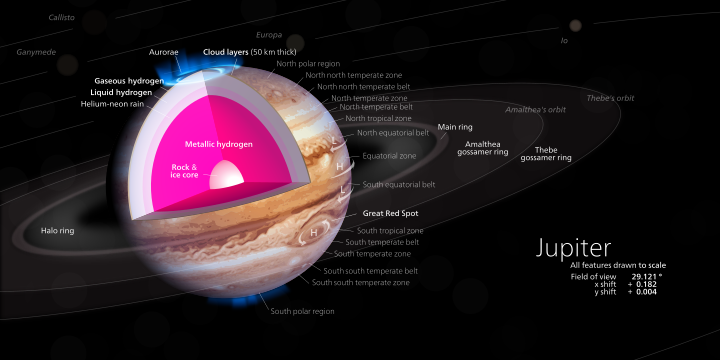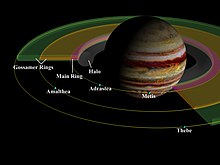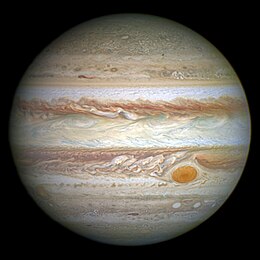Jupiter
(Jupiter: The Big giant,internal Structure, Atmosphere,Red spots,Planetary rings,Moons)
Jupiter is the fifth planet from the Sun and the largest in the Solar System. It is a giant planet
with a mass one-thousandth that of the Sun, but two and a half times
that of all the other planets in the Solar System combined. Jupiter and
Saturn are gas giants; the other two giant planets, Uranus and Neptune
are ice giants. Jupiter has been known to astronomers since antiquity.
The Romans named it after their god Jupiter. When viewed from Earth,
Jupiter can reach an apparent magnitude of −2.94, bright enough for its
reflected light to cast shadows, and making it on average the
third-brightest object in the night sky after the Moon and Venus.
Jupiter
is primarily composed of hydrogen with a quarter of its mass being
helium, though helium comprises only about a tenth of the number of
molecules. It may also have a rocky core of heavier elements, but like
the other giant planets, Jupiter lacks a well-defined solid surface.
Because of its rapid rotation, the planet's shape is that of an oblate
spheroid (it has a slight but noticeable bulge around the equator). The
outer atmosphere is visibly segregated into several bands at different
latitudes, resulting in turbulence and storms along their interacting
boundaries. A prominent result is the Great Red Spot, a giant storm that
is known to have existed since at least the 17th century when it was
first seen by telescope. Surrounding Jupiter is a faint planetary ring
system and a powerful magnetosphere. Jupiter has at least 69 moons,
including the four large Galilean moons discovered by Galileo Galilei in
1610. Ganymede, the largest of these, has a diameter greater than that
of the planet Mercury.
Jupiter
has been explored on several occasions by robotic spacecraft, most
notably during the early Pioneer and Voyager flyby missions and later by
the Galileo orbiter. In late February 2007, Jupiter was visited by the
New Horizons probe, which used Jupiter's gravity to increase its speed
and bend its trajectory en route to Pluto. The latest probe to visit the
planet is Juno, which entered into orbit around Jupiter on July 4,
2016. Future targets for exploration in the Jupiter system include the
probable ice-covered liquid ocean of its moon Europa.
Internal structure
Jupiter
is thought to consist of a dense core with a mixture of elements, a
surrounding layer of liquid metallic hydrogen with some helium, and an
outer layer predominantly of molecular hydrogen. Beyond this basic
outline, there is still considerable uncertainty. The core is often
described as rocky, but its detailed composition is unknown, as are the
properties of materials at the temperatures and pressures of those
depths (see below). In 1997, the existence of the core was suggested by
gravitational measurements, indicating a mass of from 12 to 45 times
that of Earth, or roughly 4%–14% of the total mass of Jupiter. The
presence of a core during at least part of Jupiter's history is
suggested by models of planetary formation that require the formation of
a rocky or icy core massive enough to collect its bulk of hydrogen and
helium from the protosolar nebula. Assuming it did exist, it may have
shrunk as convection currents of hot liquid metallic hydrogen mixed with
the molten core and carried its contents to higher levels in the
planetary interior. A core may now be entirely absent, as gravitational
measurements are not yet precise enough to rule that possibility out
entirely.

The
uncertainty of the models is tied to the error margin in hitherto
measured parameters: one of the rotational coefficients (J6) used to
describe the planet's gravitational moment, Jupiter's equatorial radius,
and its temperature at 1 bar pressure. The Juno mission, which arrived
in July 2016, is expected to further constrain the values of these
parameters for better models of the core.
The
core region may be surrounded by dense metallic hydrogen, which extends
outward to about 78% of the radius of the planet. Rain-like droplets of
helium and neon precipitate downward through this layer, depleting the
abundance of these elements in the upper atmosphere.
Above
the layer of metallic hydrogen lies a transparent interior atmosphere
of hydrogen. At this depth, the pressure and temperature are above
hydrogen's critical pressure of 1.2858 MPa and critical temperature of
only 32.938 K. In this state, there are no distinct liquid and gas
phases—hydrogen is said to be in a supercritical fluid state. It is
convenient to treat hydrogen as gas in the upper layer extending
downward from the cloud layer to a depth of about 1,000 km, and as
liquid in deeper layers. Physically, there is no clear boundary—the gas
smoothly becomes hotter and denser as one descends.
The
temperature and pressure inside Jupiter increase steadily toward the
core, due to the Kelvin–Helmholtz mechanism. At the pressure level of 10
bars (1 MPa), the temperature is around 340 K (67 °C; 152 °F). At the
phase transition region where hydrogen—heated beyond its critical
point—becomes metallic, it is calculated the temperature is 10,000 K
(9,700 °C; 17,500 °F) and the pressure is 200 GPa. The temperature at
the core boundary is estimated to be 36,000 K (35,700 °C; 64,300 °F) and
the interior pressure is roughly 3,000–4,500 GPa.
Atmosphere
 Jupiter has the largest planetary atmosphere in the Solar System, spanning over 5,000 km
(3,000 mi) in altitude. Because Jupiter has no surface, the base of its
atmosphere is usually considered to be the point at which atmospheric
pressure is equal to 100 kPa (1.0 bar).
Jupiter has the largest planetary atmosphere in the Solar System, spanning over 5,000 km
(3,000 mi) in altitude. Because Jupiter has no surface, the base of its
atmosphere is usually considered to be the point at which atmospheric
pressure is equal to 100 kPa (1.0 bar).Cloud layers
The
movement of Jupiter's counter-rotating cloud bands. This looping
animation maps the planet's exterior onto a cylindrical projection.
Jupiter is perpetually covered with clouds composed of ammonia crystals and possibly ammonium
hydrosulfide. The clouds are located in the tropopause and are arranged
into bands of different latitudes, known as tropical regions. These are
sub-divided into lighter-hued zones and darker belts. The interactions
of these conflicting circulation patterns cause storms and turbulence.
Wind speeds of 100 m/s (360 km/h) are common in zonal jets. The zones
have been observed to vary in width, color and intensity from year to
year, but they have remained sufficiently stable for scientists to give
them identifying designations.
The
cloud layer is only about 50 km (31 mi) deep, and consists of at least
two decks of clouds: a thick lower deck and a thin clearer region. There
may also be a thin layer of water clouds underlying the ammonia layer.
Supporting the idea of water clouds are the flashes of lightning
detected in the atmosphere of Jupiter. These electrical discharges can
be up to a thousand times as powerful as lightning on Earth. The water
clouds are assumed to generate thunderstorms in the same way as
terrestrial thunderstorms, driven by the heat rising from the interior.
The
orange and brown coloration in the clouds of Jupiter are caused by
upwelling compounds that change color when they are exposed to
ultraviolet light from the Sun. The exact makeup remains uncertain, but
the substances are thought to be phosphorus, sulfur or possibly
hydrocarbons. These colorful compounds, known as chromophores, mix with
the warmer, lower deck of clouds. The zones are formed when rising
convection cells form crystallizing ammonia that masks out these lower
clouds from view.
Jupiter's
low axial tilt means that the poles constantly receive less solar
radiation than at the planet's equatorial region. Convection within the
interior of the planet transports more energy to the poles, balancing
out the temperatures at the cloud layer.
Great Red Spot and other vortices
 Time-lapse
sequence from the approach of Voyager 1, showing the motion of
atmospheric bands and circulation of the Great Red Spot. Recorded over
32 days with one photograph taken every 10 hours (once per Jovian day).
See full size video.
Time-lapse
sequence from the approach of Voyager 1, showing the motion of
atmospheric bands and circulation of the Great Red Spot. Recorded over
32 days with one photograph taken every 10 hours (once per Jovian day).
See full size video.
The
best known feature of Jupiter is the Great Red Spot, a persistent
anticyclonic storm that is larger than Earth, located 22° south of the
equator. It is known to have been in existence since at least 1831, and
possibly since 1665. Images by the Hubble Space Telescope have shown as
many as two "red spots" adjacent to the Great Red Spot. The storm is
large enough to be visible through Earth-based telescopes with an
aperture of 12 cm or larger. The oval object rotates counterclockwise,
with a period of about six days. The maximum altitude of this storm is
about 8 km (5 mi) above the surrounding cloudtops.
The
Great Red Spot is large enough to accommodate Earth within its
boundaries. Mathematical models suggest that the storm is stable and may
be a permanent feature of the planet. However, it has significantly
decreased in size since its discovery. Initial observations in the late
1800s showed it to be approximately 41,000 km (25,500 mi) across. By the
time of the Voyager flybys in 1979, the storm had a length of 23,300 km
(14,500 mi) and a width of approximately 13,000 km (8,000 mi). Hubble
observations in 1995 showed it had decreased in size again to 20,950 km
(13,020 mi), and observations in 2009 showed the size to be 17,910 km
(11,130 mi). As of 2015, the storm was measured at approximately 16,500
by 10,940 km (10,250 by 6,800 mi), and is decreasing in length by about
930 km (580 mi) per year.
Storms
such as this are common within the turbulent atmospheres of giant
planets. Jupiter also has white ovals and brown ovals, which are lesser
unnamed storms. White ovals tend to consist of relatively cool clouds
within the upper atmosphere. Brown ovals are warmer and located within
the "normal cloud layer". Such storms can last as little as a few hours
or stretch on for centuries.
Even
before Voyager proved that the feature was a storm, there was strong
evidence that the spot could not be associated with any deeper feature
on the planet's surface, as the Spot rotates differentially with respect
to the rest of the atmosphere, sometimes faster and sometimes more
slowly.
In
2000, an atmospheric feature formed in the southern hemisphere that is
similar in appearance to the Great Red Spot, but smaller. This was
created when several smaller, white oval-shaped storms merged to form a
single feature—these three smaller white ovals were first observed in
1938. The merged feature was named Oval BA, and has been nicknamed Red
Spot Junior. It has since increased in intensity and changed color from
white to red.
In
April 2017, scientists reported the discovery of a "Great Cold Spot" in
Jupiter's thermosphere at its north pole that is 24,000 km (15,000 mi)
across, 12,000 km (7,500 mi) wide, and 200 °C (360 °F) cooler than
surrounding material. The feature was discovered by researchers at the
Very Large Telescope in Chile, who then searched archived data from the
NASA Infrared Telescope Facility between 1995 and 2000. They found that,
while the Spot changes size, shape and intensity over the short term,
it has maintained its general position in the atmosphere across more
than 15 years of available data. Scientists believe the Spot is a giant
vortex similar to the Great Red Spot and also appears to be quasi-stable
like the vortices in Earth's thermosphere. Interactions between charged
particles generated from Io and the planet's strong magnetic field
likely resulted in redistribution of heat flow, forming the Spot.
Moons
Jupiter
has 69 known natural satellites. Of these, 53 are less than 10
kilometres in diameter and have only been discovered since 1975. The
four largest moons, visible from Earth with binoculars on a clear night,
known as the "Galilean moons", are Io, Europa, Ganymede, and Callisto.
Planetary rings
 Jupiter
has a faint planetary ring system composed of three main segments: an
inner torus of particles known as the halo, a relatively bright main
ring, and an outer gossamer ring. These rings appear to be made of dust,
rather than ice as with Saturn's rings. The main ring is probably made
of material ejected from the satellites Adrastea and Metis. Material
that would normally fall back to the moon is pulled into Jupiter because
of its strong gravitational
influence. The orbit of the material veers towards Jupiter and new
material is added by additional impacts. In a similar way, the moons
Thebe and Amalthea probably produce the two distinct components of the
dusty gossamer ring. There is also evidence of a rocky ring strung along
Amalthea's orbit which may consist of collisional debris from that
moon.
Jupiter
has a faint planetary ring system composed of three main segments: an
inner torus of particles known as the halo, a relatively bright main
ring, and an outer gossamer ring. These rings appear to be made of dust,
rather than ice as with Saturn's rings. The main ring is probably made
of material ejected from the satellites Adrastea and Metis. Material
that would normally fall back to the moon is pulled into Jupiter because
of its strong gravitational
influence. The orbit of the material veers towards Jupiter and new
material is added by additional impacts. In a similar way, the moons
Thebe and Amalthea probably produce the two distinct components of the
dusty gossamer ring. There is also evidence of a rocky ring strung along
Amalthea's orbit which may consist of collisional debris from that
moon.










0 comments:
Post a Comment